|
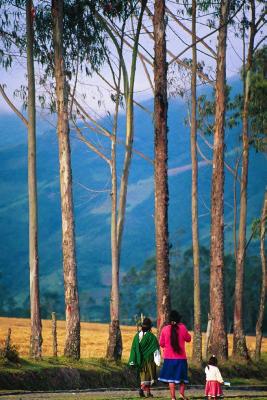 North of Quito one passes
through parched lands. Roads snake down to dry rivers, only
to coil back up to even drier passes. The odd talisman of green
flourishes, but otherwise the hills are tanned to Andalucian
aridity. North of Quito one passes
through parched lands. Roads snake down to dry rivers, only
to coil back up to even drier passes. The odd talisman of green
flourishes, but otherwise the hills are tanned to Andalucian
aridity.
Some 100 kilometres out, one approaches the great dormant
volcano of Imbabura, and the thirsty landscape begins to receive
more rain. Once the dust has turned to tillable earth, the Pan-American
Highway descends towards the lake of San Pablo, with the
town of Otavalo guarding its northern shores. Driving along
the lakeside road, fields stretch down to the shore, while peasants
drive their cattle along the grassy fringes.
WEAVING TALES
Otavalo hosts probably the
most famous tourists' market in South America, and most definitely
Ecuador's most important. The Otavalan Indians are renowned
for their textiles and weaving, but also for their business
acumen, and ambition. They rank among the continent's most
prosperous indigenous people, proud of their heritage - they
still wear their colonial-traditional dress - and yet able
to take advantage of the First World's need for souvenirs,
bright colours and fake plenties.
The men of Otavalo wear three-quarter
length white trousers, white alpargata shoes beneath them,
flowing dark ponchos, and hats of differing sizes and colours.
The women are instantly recognisable by the layers of gold
necklaces which throng their necks, but also by their black
or dark blue full-length skirts and beautiful, puffy white
blouses embroidered with colourful patterns, lengths of dark
cloth folded around their heads shading them from the midday
sun.
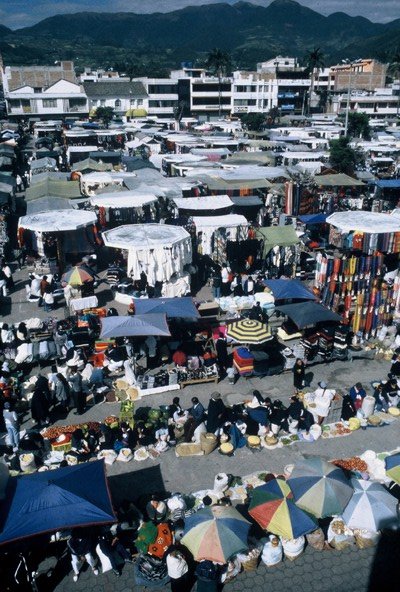 The town's biggest day is market day, Saturday.
But such is the popularity of Otavalan produce (though a large
part also comes from other parts of the country) you can visit
any day of the week and still find the Plaza de los Ponchos
muffled by stalls. On Saturdays, hundreds of stands plug the
avenues leading to the square, the ones running east slowly
becoming less touristy, dominated by pots and pans and tupperware,
until you reach the arcades of the produce market, jammed
with piles of every variety of fruit, vegetable, fish and
meat. The weavings are beautiful, ranging from rugs of symmetric
red, brown and blue patterns, dark tightly-woven ponchos,
bright woolly hats festooned with flowers, the oranges, yellows
and greens of hammocks, through to quite Westernised sweaters
and zip-up tops of just a few colours. The town's biggest day is market day, Saturday.
But such is the popularity of Otavalan produce (though a large
part also comes from other parts of the country) you can visit
any day of the week and still find the Plaza de los Ponchos
muffled by stalls. On Saturdays, hundreds of stands plug the
avenues leading to the square, the ones running east slowly
becoming less touristy, dominated by pots and pans and tupperware,
until you reach the arcades of the produce market, jammed
with piles of every variety of fruit, vegetable, fish and
meat. The weavings are beautiful, ranging from rugs of symmetric
red, brown and blue patterns, dark tightly-woven ponchos,
bright woolly hats festooned with flowers, the oranges, yellows
and greens of hammocks, through to quite Westernised sweaters
and zip-up tops of just a few colours.
To add to the textiles,
stalls also overflow with musical instruments (those infernal
whirly drum things and the inevitable panpipes); intricately-painted
ceramic bowls; miniature paintings from the Indians of Tigua,
masters of representing their world of puffing volcanoes,
fluffy lamas and busying locals; wood carvings of jagged-jowled
men; and jewellery of every size and description. Although
undeniably a tourist trap, the quality of the crafts on sale
is so high I didn't mind feeling like another gringo. I enjoyed
bargaining with wrinkly old women and fresh-faced young girls
for dinky sweaters for my nephews and nieces.
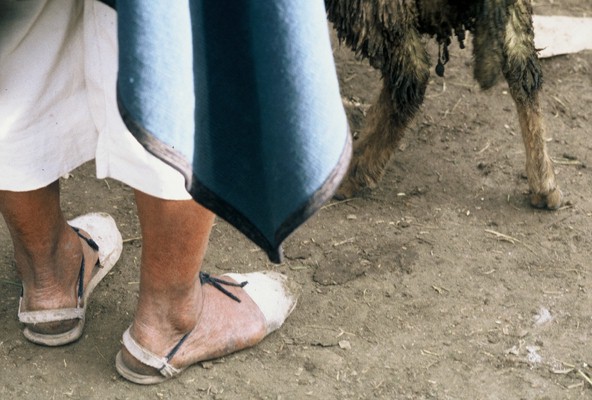 ANIMAL FARM ANIMAL FARM
Bartering of another kind
takes place early on Saturday morning, at the animal market
on the eastern outskirts of town. Each animal has a particular
section in the outdoor market. You enter through a hole in
the barbed wire fence where officials tax the buyers 20 cents
on every purchase.
You're immediately squelching in the mud
of hundreds of trotters and barefooted Indians, as swine ranging
from the squealing weeks-old piglets to the mammoth 160-kilo
(354-pound) hog are inspected, haggled over and eventually
sold. Indian women tethered cords which fanned out to runts
of piglets happily rooting around in the mud for scraps, while
a mestizo family threw pigs out of the back of their van to
buyers who prised the poor animals' jaws open with crowbars
below. After the pigs come the sheep, huddled in bleating
flocks around their owners, and then the cows and the occasional
bull of all sizes and colours, insouciantly splurging cowpats
and urinating while their masters decided their fates.
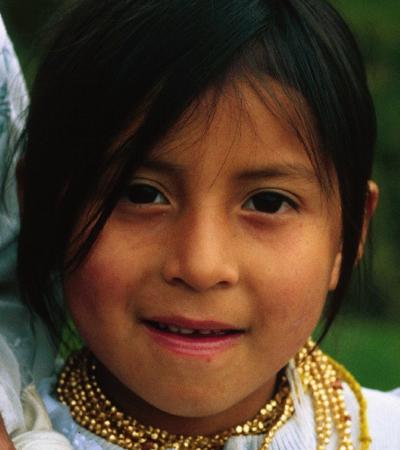 None of the locals paid the odd tourist the slightest bit
of attention, and my friend Rafael and I went around interviewing
the peasants, asking them where they were from, how much they
expected their cow to fetch and what the weather was going
to do. Most of them still talked in sucres, Ecuador's old
currency, even though it's 16 months since the economy was
'dollarized' (an ugly word for an ugly thing). None of the locals paid the odd tourist the slightest bit
of attention, and my friend Rafael and I went around interviewing
the peasants, asking them where they were from, how much they
expected their cow to fetch and what the weather was going
to do. Most of them still talked in sucres, Ecuador's old
currency, even though it's 16 months since the economy was
'dollarized' (an ugly word for an ugly thing).
I ran around
taking surreptitious photos, managing to catch the woman who
had a sheep instead of a baby slung around her back, but failing
to get the old woman clasping two large cockerels beneath
her ample bosom, only their heads and claws emerging from
the folds of her embroidered, billowing blouse.
WORD OF MOUTH
In the afternoon, Rafael
and I went to visit one of the few Quichua-speaking (indigenous)
radio stations in the country. It was located in a village
to the north, where a football game captured the attention
of the locals and tightly-sown fields of corn divided the
houses, in a dingy, dank room at the back of a semi-abandoned
house.
The station, Radio Ilumán 96.7 FM, was manned that
afternoon by two young guys. They were very wary of answering
questions at first, but opened up after Rafael allayed their
fears. About 90% of the station's output was in Quichua, beginning
at 5 am with a programme whose name, Rikcharishun, translates
as 'Happy to Awake' (a tad optimistic?), and followed by the
news at 7 am in the programme Shimi Willachick, which means
roughly 'from the mouth'. Educational and health pieces punctuated
the diet of Andean folk music. some of the groups smiled
out from the posters which adorned the peeling walls: Byron
Solis, Marga Lugue "La Pequeña Gigante de la Canción",
and Pepe Richard y su Nueva Generación, posing in a field
of potatoes and pylons.
The station reached the whole
Otavalo area. Much to our surprise, and my stupefaction, the
teenagers turned the tables on us: we ended up being interviewed
live on air about what we were doing and what we thought of
Ecuador and the Imbabura region. I managed to say hello to
my Mum before dribbling something hopefully half-meaningful
into the squeaking microphone.
LA ESPERANZA
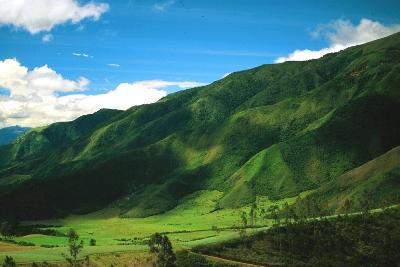
On the other side of the Imbabura
volcano from Lago San Pablo and Otavalo, there's a small village
folded into the hills called La Esperanza.
From here, Bolívar
gathered his troops before taking the provincial capital of
Ibarra from the Spanish. Today, travellers gather mushrooms,
and go for spaced-out hikes up the mountain. The hills all
around are furiously cultivated and when not, are peopled
by herds of black and white cows.
Rafael, his fellow radio-friend
Jesse and I set off on the old cobbled and rutted road that
leads round the mountain. It wound through the coloured terraces
of fields, ringing the hills like the seats of an amphitheatre,
divided by mud-packed brown walls topped by sprouting green
bushels or bright yellow rape-seed. The road only twice divided
for no good reason and with no indication as to which was
the right way. We had to wait for a local to come along and
tell us what must have seemed blindingly obvious to them.
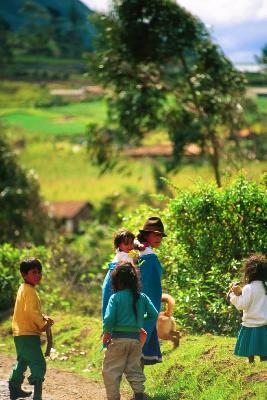 Rafael had
spent some time in La Esperanza when he lived in Ecuador.
It boasts all of two hosterías. One is posher than the other,
which makes it sound luxurious. It isn't. My room's ceiling
was composed of coarse sacking, the bed was older than me,
and the doorlock was a length of string. Rafael had
spent some time in La Esperanza when he lived in Ecuador.
It boasts all of two hosterías. One is posher than the other,
which makes it sound luxurious. It isn't. My room's ceiling
was composed of coarse sacking, the bed was older than me,
and the doorlock was a length of string.
The other posada
was more run-down and currently undergoing serious restructuring.
Most of the back patio had been excavated to make way for
new plumbing. Intense rivalry flowed between the two establishments,
and the two women who ran them. Maria, the one from the cheaper
place, much to Rafael's astonishment, had emigrated to near
Valencia in Spain. Just one of the flood of tens of thousands
of Ecuadorians who have fled the economic crisis, only to
be coldly-received or repatriated in Europe or the States.
Maria's son, Patricio, now
ran the place. The entrance led into a large echoing room,
the comedor-cum-bar. It had been painted at some point with
alpine scenes, the bar top and stools were straight out of
the seventies, and various trophies for cycling, running and
speed-walking won by Patricio vied for dust in a glass vitrine.
The room looked pretty shabby until we lit it with candles
and put some Santana on the stereo - the only thing that didn't
date from the last decade in the house.
There we met a Frenchman,
Stéphane, a Breton who made so much money baking pizzas and
living in a bus in the summer months in Bretagne that he spent
most of the rest of the year travelling. He'd worked as a
chef across the American continent, most recently in Ushuaia,
the most austral town in the world at the bottom of Tierra
del Fuego. He immeasurably redeemed the French people in my
eyes - I've been losing faith in them steadily since my first
Lycée day I think.
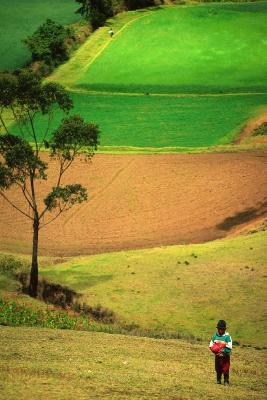 He had been travelling on and off for the last
sixteen years; he was now a tanned, slightly wrinkled 36.
He ranks among the most friendly people I've met, in the sense
that he'll make friends with anyone, with an insouciance and
joie-de-vivre that takes years to achieve. Some people then
lather themselves with this mañana mentality, and seem
to wallow in their I'm-so-relaxedness. He didn't. He had also
achieved another rare state of being: generosity. Whether
rolling a joint from his stash, sharing his knowledge of the
country or his travels, or buying and cooking us all trout
one night, his altruism filled me with warmth. He had been travelling on and off for the last
sixteen years; he was now a tanned, slightly wrinkled 36.
He ranks among the most friendly people I've met, in the sense
that he'll make friends with anyone, with an insouciance and
joie-de-vivre that takes years to achieve. Some people then
lather themselves with this mañana mentality, and seem
to wallow in their I'm-so-relaxedness. He didn't. He had also
achieved another rare state of being: generosity. Whether
rolling a joint from his stash, sharing his knowledge of the
country or his travels, or buying and cooking us all trout
one night, his altruism filled me with warmth.
We went for a walk one afternoon,
(shortly before my jeep broke down to be ignominiously towed
back to town by an old tractor). Up in the hills, we played
football on the mud road with three un-breathless boys who
stormed into the fields of corn every time the ball was kicked
awry. They disappeared, only for the ball to come magically
flying out of the rows of swaying leaves.
At the top of a
hill, we were rewarded with fleeting glimpses of the glorious,
snow-capped Cayambe volcano. We passed various families with
their animals, tilling the fields or making their way along
other eucalyptus-lined lanes.
We stopped at a house with a
'Coca Cola aqui' sign in what seemed like the middle of nowhere.
It was amazingly well stocked, despite the floor being of
compacted earth, and the family living in a penumbrous mud-walled
house. Just by the door to the shop, above the bench for sitting
on, painted lettering read 'Paz, sonrisa del mundo' (Peace,
smile of the world).
PINSAQUI
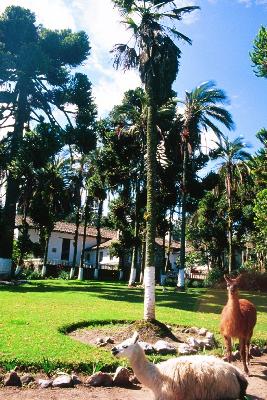 Pedro Freile has a smile for most people. Pedro
belongs to the family that owns Hacienda Pinsaquí, to the
north of Otavalo. The house has been in the hands of the Freile
family for six generations now, and only opened its doors
to paying guests seven years ago. Pedro Freile has a smile for most people. Pedro
belongs to the family that owns Hacienda Pinsaquí, to the
north of Otavalo. The house has been in the hands of the Freile
family for six generations now, and only opened its doors
to paying guests seven years ago.
There are in fact three Pedro
Freiles. The elder, now in his sixties, is renowned for his
love of horses. He is famous for greeting his guests in the
bar for an aperitif - on horseback. There are photos of him
with a magnificent chestnut Arab - in the master bedroom.
The second Pedro is the one I met, with the gait and demeanour
of someone who has grown up wealthy and powerful. He too is
equinely-inclined, leading the third Pedro, who must be about
eight, on horse-back rides through the hacienda's grounds.
The house's furniture, including
an exquisite chandelier and a behemoth writing desk, comes
mainly from France and Europe. It was brought back by the
free-wheeling and free-spending Freile of the early 20th century
(thankfully not called Pedro, but ironically named Modesto),
who was, interestingly, rumoured to have been a lover of Frida
Kahlo while ambassador to Mexico.
I had a chat with Pedro in
one of the hacienda's salons. Pinsaquí's cobbled paths and
walls are thick with history. On his troubled travels to and
from Bogotá and Quito, Simón Bolívar would stay at the hacienda,
and though unproven, doubtless met his lover Manuela Sáenz
here for furtive fumblings, before returning to "plough
the sea" of Latin American independence. In the late
19th century, the hacienda hosted the peace treaty drawn up
between Colombia and Ecuador after the Ecuadorian president
had backed the wrong horse (the conservatives) in one of Colombia's
endless civil wars.
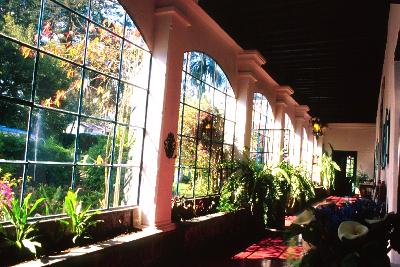 Pedro, an amiable man, his face of thirty-odd
just giving in to bon-viveur chubbyness, grappled with the
dates, and doesn't seem the intellectual type. The events
he recounted, instead of coming to life, seemed to float about
in the tall ceilings of the room. He didn't seem passionate,
turned on to anything he spoke of, apart from horses. He was
somehow detached from it all, in the way only an absentee
landlord can be. Pedro, an amiable man, his face of thirty-odd
just giving in to bon-viveur chubbyness, grappled with the
dates, and doesn't seem the intellectual type. The events
he recounted, instead of coming to life, seemed to float about
in the tall ceilings of the room. He didn't seem passionate,
turned on to anything he spoke of, apart from horses. He was
somehow detached from it all, in the way only an absentee
landlord can be.
He didn't try to justify his life, or his
family's history. The fact that in the nineteenth century
the hacienda ranged over some 7,000 hectares (17,000 acres),
and had some 1,000 Indians working their hands bare on its
textile looms, didn't mean he then told me about their present-day
progressive social programmes. Because they don't have any.
Or at least, he didn't bother to mention them.
One approaches the main house
through imposing gates, the front garden rolling down to a
burbling fountain at the hacienda's main entrance, which then
divides into two wings. At the gate, on every occasion I drove
up, a different generation of one family came scuttling out
of the gatehouse to open it. From an old wrinkly Indian man,
to his sad-eyed son, to his eyes-downturned granddaughter.
I imagine the old man has been opening the gate all his life,
and wonder if his son, and granddaughter, will do the same.
Although the Otavalan Indians have come a long way, becoming
successful entrepreneurs, radio disk-jockeys, mayors and even
congressional deputies, there are some corners of Ecuador
that will forever be Pinsaquí.
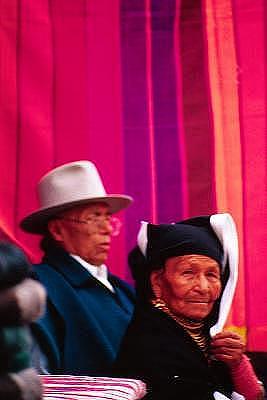 |
While
in the Otavalo area, a beautiful place to stay up in
the surrounding hills is Casa Mojanda.
Contact Betti and Diego, and tell them we sent you!

"A journey and a destination"
A beautiful, ecological retreat
in the hills above Otavalo
|
|